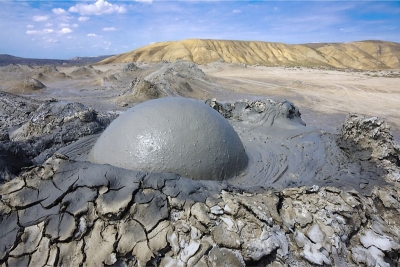
A massive explosion and a towering inferno above the Caspian Sea caught international attention recently. Initially, it was thought to be an accident in one of Azerbaijan’s multiple offshore oil and gas fields in the area, but investigations revealed that the blast was caused by an underwater mud volcano.
The blast took place about 10km from the Umid gas field, 75 km off the coast of the capital, Baku. The location of the fire roughly points to a mud volcano called Makarov Bank, which exploded in 1958, releasing a column of flame 500-600 metres high and 150 metres wide.
What are mud volcanoes?
Mud volcanoes are a rare type of volcano that erupt in the form of a superheated slurry of mud and water, unlike igneous volcanoes which produce lava. They are not necessarily driven by magmatic activity. Several geological processes may cause the formation of mud volcanoes. Some mud volcanoes are created hot-spring by hot- activity where large amounts of gas react with water and surrounding rocks to form boiling mud Steam from heated water deep underground forces mud through an opening or fissure in the ground Some mud volcanoes occur only in oil-field regions Under stress, methane and related hydrocarbon gases mixed with mud force their way upward and burst through to the surface, spewing mud in a cone-like shape. This mud is often hot and may have an accompanying steam cloud. The gas that builds up inside can be ignited by sparks created by fast-moving rocks and boulders beneath the surface during eruptions. This is believed to have caused the recent inferno in the Caspian Sea.
Mud volcanoes exist around the world, from Indonesia to Italy But some of the greatest concentrations of mud volcanoes on Earth exist near Azerbaijan Azerbaijan has around 400 of the roughly 1,000 known mud volcanoes on Earth, which, along with its abundance of oil and gas reserves has earned the country the nickname Land of Fire Most mud volcanoes are situated on small islands created by their eruptions, but some are hidden below the surface and form temporary peaks above the water when active The mud volcanoes in Azerbaijan are some of the biggest and most violent in the world The size of small mud volcanoes can be as high as four feet. Lusi in Indonesia is the largest mud volcano at 2300 feet El Totumo in Colombia at 50 feet high is believed to spew out mud with medicinal properties. Many people visit the volcano to lie on its mud.
Picture Credit : Google




